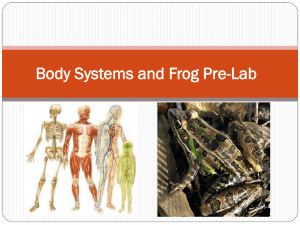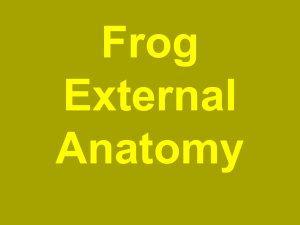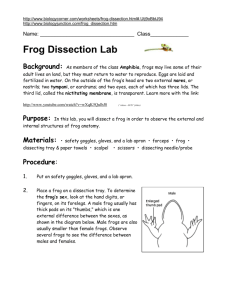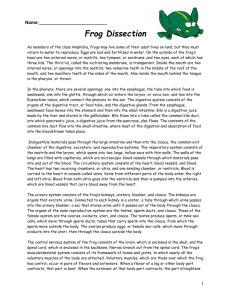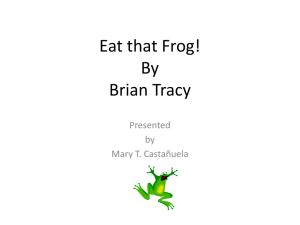Frog Anatomy Study Guide Answer Key
advertisement
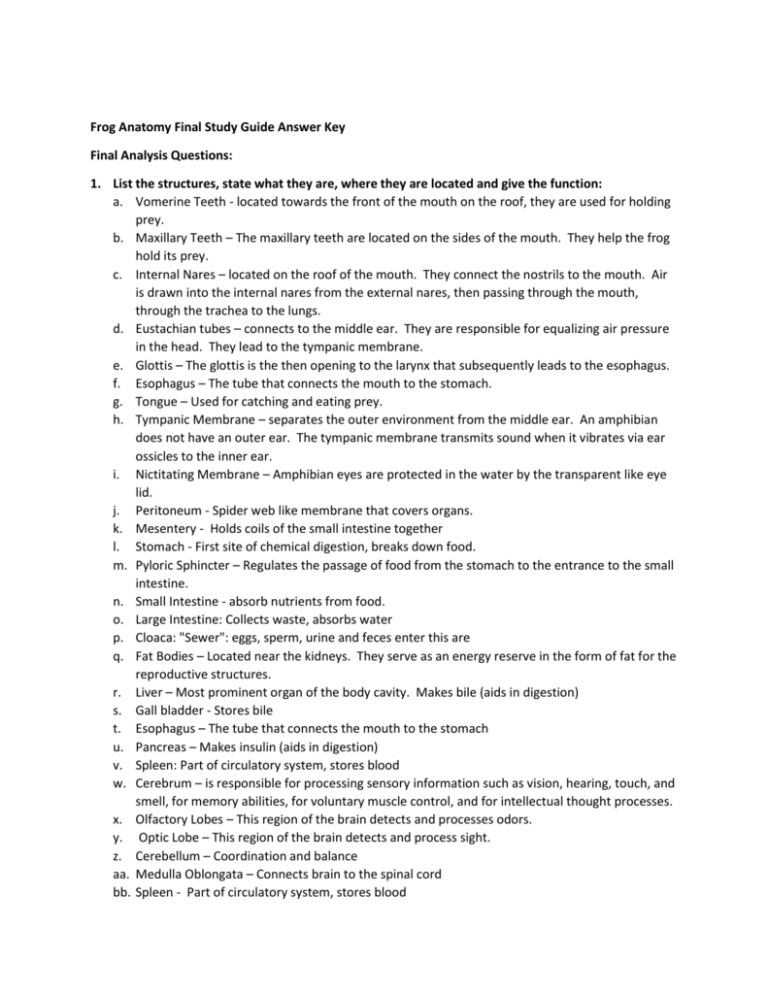
Frog Anatomy Final Study Guide Answer Key Final Analysis Questions: 1. List the structures, state what they are, where they are located and give the function: a. Vomerine Teeth - located towards the front of the mouth on the roof, they are used for holding prey. b. Maxillary Teeth – The maxillary teeth are located on the sides of the mouth. They help the frog hold its prey. c. Internal Nares – located on the roof of the mouth. They connect the nostrils to the mouth. Air is drawn into the internal nares from the external nares, then passing through the mouth, through the trachea to the lungs. d. Eustachian tubes – connects to the middle ear. They are responsible for equalizing air pressure in the head. They lead to the tympanic membrane. e. Glottis – The glottis is the then opening to the larynx that subsequently leads to the esophagus. f. Esophagus – The tube that connects the mouth to the stomach. g. Tongue – Used for catching and eating prey. h. Tympanic Membrane – separates the outer environment from the middle ear. An amphibian does not have an outer ear. The tympanic membrane transmits sound when it vibrates via ear ossicles to the inner ear. i. Nictitating Membrane – Amphibian eyes are protected in the water by the transparent like eye lid. j. Peritoneum - Spider web like membrane that covers organs. k. Mesentery - Holds coils of the small intestine together l. Stomach - First site of chemical digestion, breaks down food. m. Pyloric Sphincter – Regulates the passage of food from the stomach to the entrance to the small intestine. n. Small Intestine - absorb nutrients from food. o. Large Intestine: Collects waste, absorbs water p. Cloaca: "Sewer": eggs, sperm, urine and feces enter this are q. Fat Bodies – Located near the kidneys. They serve as an energy reserve in the form of fat for the reproductive structures. r. Liver – Most prominent organ of the body cavity. Makes bile (aids in digestion) s. Gall bladder - Stores bile t. Esophagus – The tube that connects the mouth to the stomach u. Pancreas – Makes insulin (aids in digestion) v. Spleen: Part of circulatory system, stores blood w. Cerebrum – is responsible for processing sensory information such as vision, hearing, touch, and smell, for memory abilities, for voluntary muscle control, and for intellectual thought processes. x. Olfactory Lobes – This region of the brain detects and processes odors. y. Optic Lobe – This region of the brain detects and process sight. z. Cerebellum – Coordination and balance aa. Medulla Oblongata – Connects brain to the spinal cord bb. Spleen - Part of circulatory system, stores blood Additional Discussion Questions – 1. In what ways is the frog similar to other vertebrates? How is it different? The frog is similar to other vertebrates in such a way that, like man, the frogs have the same kinds of organs and systems of organs. The frog has an endoskeleton system. A frog has a dorsal hollow nerve cord like other vertebrates. The frog has closed circulatory system like other vertebrates. They are different because they have no ears, are cold blooded and have to be near or in water most of their lives. 2. Which structures provide evidence that the frog has a partially aquatic lifestyle? The frog has webbed feet which provide fluid friction against water. This is how they are able to get around in the water. The frog also has a nictitating membrane which is a clear eyelid that helps the frog see under the water. 3. What are some of the major amphibian characteristics that a frog exhibits? Some of the major amphibian characteristics that the frog exhibits is that it can breathe through its skin and lungs. Frogs also have webbed feet which is common of most amphibians. Frogs must live in moist environments to sustain life. 4. During one mating of frogs, the female lays some 2,000 to 3,000 eggs in water as the male sheds millions of sperm over them. How do these large numbers related to the frog’s fitness for life in water? A male frog sheds millions of sperm and female shed 2,000 to 3,000 in the water, with these numbers the survival rate increases. In water the eggs and sperm are small making them victims to be eaten by other animals, having this amount of egg and sperm increases the chance of having offspring. 5. Sequence the passage of food in the frog from the time it swallows a bug to the time it expels its remains. The food enters the mouth, goes through the esophagus to the stomach. The food is then digested and pushed into the small intestine. From the small intestine, it is then pushed into the large intestine. Once in the large intestine, water and more nutrients are absorbed and the frog then expels the any unused portions of the food. Post Lab Questions: 6. 7. 8. 9. 10. 11. 12. 13. 14. 15. 16. 17. 18. The membrane that holds the coils of small intestine together is called the mesentery. This organ is found under the liver, it stores bile gall bladder The organ that is the first major site of chemical digestion: the stomach Eggs, sperm, urine, and wastes all empty into this structure: The Cloaca The small intestine leads to the Large intestine The esophagus leads to the stomach Yellowish structures that serve as an energy reserve fat bodies After food passes through the stomach it enters the: small intestine The first part of the small intestine (straight part) : duodenum The second part is called the ileum. The membrane that covers the organs is the Peritoneum. The large intestine leads to the Cloaca Organ found within the mesentery that stores blood: The spleen. The largest organ in the body cavity: The liver Identify the organs on the frog below: A. B. C. D. E. F. G. H. I. J. K. L. M. Esophagus Aortic arch Stomach Pancreas Small intestine duodenum Cloaca Aortic arch Lung Heart Liver Gall Bladder Small intestine ileum Large intestine Frog Brain A. B. C. D. E. Olfactory Lobe Cerebrum Optic Lobe Cerebellum Medulla Oblongata
